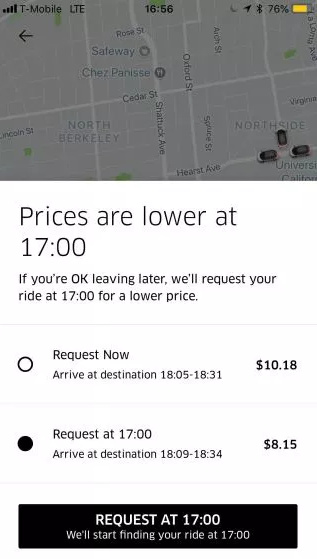In their ever-increasing desire to dominate the US market, Uber has instigated a new service; this is their UberWait service. UberWait is essentially a service for customers that are not in a rush and wish to pay less for the same ride.

How is this done?
Simple, the Uber algorithm estimates the fares within a specific time limit from the moment the customer requests the ride. If the cheaper ride is within a few minutes from the originally requested ride time, then the difference can be as big as 25%.
For some reason though, Uber has not gone public with this, the PR machine is keeping quiet, and this service was first noticed by an Uber employee while waiting for a ride.
According to media sources; the screen image showed the customer that he could request a ride "now" (4:56 pm local time) for $10.18, or wait 4 minutes, and request a ride at 5 pm paying $8.15, which is about 25% less. "If you're OK leaving later, we'll request your ride at 17:00 for a lower price," Uber's app stated.
OK, so what's the big deal and why all the hush hush?
There are some reasons that we can think of, and they include the fact that Uber is trying to capture back some of their lost customers to rising ride prices.
Lyft s still cheaper than Uber, so a reduced ride would help bring back some of those money conscious customers.
Another reason is that not everyone is in a rush, and a company that offers you a cheaper ride is going to sell better than a company that delivers a driver.
This is customer psychology 101, get into the good books of the customer by providing a cheaper option for the same quality and standards of service.
When it's a matter of a few minutes, even ten minutes extra waiting for someone not in a rush, that $4 savings are a lot. Giving a choice is always good, especially when the choice is to pay less for the same.
The Psychology of Numbers
Now you are asking, if Uber is losing so much money every year, why are they willing to charge less for a ride that would be taken anyway?
Well, here's the clincher.
If Uber can raise the number of customers, it is taking; it will overall increase its income. The number of rides Uber provides yearly is over a billion, when you consider that a small percentage of rides will be offered cheaper due to the location and saturation of drivers, then the increase in customers will provide a shift over time to the benefit of Uber.
You have to realize that the algorithm will not offer this to everyone all the time. This is a time and saturation-based algorithm that balances between the changes in fares by time periods (surge etc.) and the location of the customer.
So, if you live in the center of SF and need a ride, you will enjoy this service, since SF is heavily saturated with Uber drivers all the time.
Now let's look at high saturation again.
Imagine you are in a surge, you need a ride; there are not enough drivers, you might consider using an alternative transportation method.
So, how does Uber tackle this? They offer you the same ride a few minutes later at a lower price. Ingenious!
What Uber has done with UberWait is tap into an undercurrent of latent passengers that use Uber but will use a competitor when there is no alternative.
Also, since Uber knows many passengers balk at the high surge prices, offering a cheaper alternative that is a few minutes later is considered a kind gesture.
This shift in demand will provide Uber with two advantages; the first is that it will reduce surges since people will agree to wait a while for the surge to pass.
It will also create longer lower surges, where the price is lower than the 2x or 3x surge price, but in reality, is a 1.5x price.
Uber still wins, you still pay more than you would for a normal rate, but you pay far less than you would in a major surge.
Surges
When you balance out the income from a longer minor surge, then a quickly peaked major one, you will earn more. The number of rides will provide a higher income, and that is a win-win situation for Uber and the passenger.
Now let's look at the driver. Does the driver win too? Definitely yes, the driver still gets a ride, after all, if the passenger is willing to pay the base rate or more than the driver doesn't lose out.
In fact, it seems that the spreading of a surge will democratize surges. This means more drivers will enjoy a 1.25 or 1.5x pricing, than the few that successfully get the x2 to x5 pricings.
Bottom Line
One of the key issues that have been discussing in every regulatory forum is the traffic effect that ridesharing has on communities. This is one of Uber's masterstrokes. How to reduce the demand for a peak by spreading the demand over a longer period.
It takes time to learn and adapt, that is what is happening with Uber. This is a learning curve, the reason they have kept quiet is that they haven't yet generated enough demographic income data to corroborate their concept.
Once UberWait has been fully tested in SF, then Uber will decide to integrate it as a full-time service, possibly not only in the US but all over the world. Then the PR machine will come alive, so, for now, we have to wait for the user wait.
